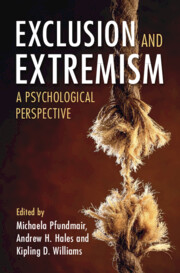Book contents
- Exclusion and Extremism
- Exclusion and Extremism
- Copyright page
- Dedication
- Contents
- Contributors
- Introduction
- Part I The Link between Exclusion and Extremism
- Part II Drivers of the Exclusion–Extremism Link
- 6 Extremism and Exclusion
- 7 Divided Groups, Polarized Identities, and Extremist Behavior
- 8 It’s the Group, Not Just the Individual
- 9 “Who Do They Think We Are?!”
- 10 The Exclusion–Extremism Link in Non-WEIRD Populations
- Part III Topics Related to the Exclusion–Extremism Link
- Index
- References
8 - It’s the Group, Not Just the Individual
Social Identity and Its Link to Exclusion and Extremism
from Part II - Drivers of the Exclusion–Extremism Link
Published online by Cambridge University Press: 16 May 2024
- Exclusion and Extremism
- Exclusion and Extremism
- Copyright page
- Dedication
- Contents
- Contributors
- Introduction
- Part I The Link between Exclusion and Extremism
- Part II Drivers of the Exclusion–Extremism Link
- 6 Extremism and Exclusion
- 7 Divided Groups, Polarized Identities, and Extremist Behavior
- 8 It’s the Group, Not Just the Individual
- 9 “Who Do They Think We Are?!”
- 10 The Exclusion–Extremism Link in Non-WEIRD Populations
- Part III Topics Related to the Exclusion–Extremism Link
- Index
- References
Summary
In this chapter, we first address the question of why groups are so much “better at” terrorism than individuals. Specifically, we argue that, when trying to explain terrorism, it makes more sense to consider people’s social identities than their personal identities, and thus to focus on the group rather than the individual. We present seven pieces of evidence for this idea. Subsequently, we describe studies in which we employ a new paradigm called “Bovenland” to study experimentally the role of multiple and ongoing threats to one’s social identity (in terms of exclusion) in explaining inaction, normative, and (extreme) nonnormative behavior. We conclude by articulating how and when threats to one’s social identity are associated with the need to restore one’s image by displaying violent behavior.
Keywords
- Type
- Chapter
- Information
- Exclusion and ExtremismA Psychological Perspective, pp. 166 - 183Publisher: Cambridge University PressPrint publication year: 2024

